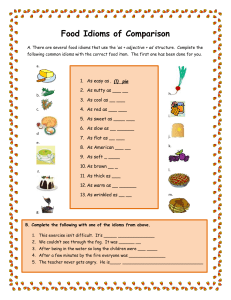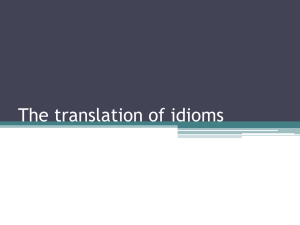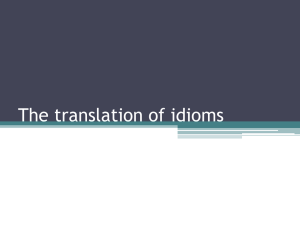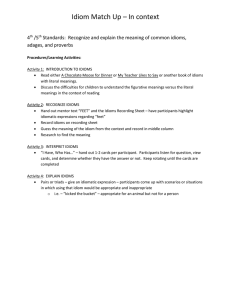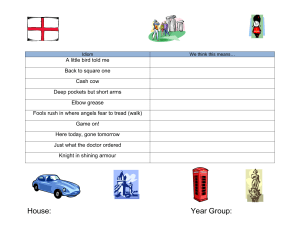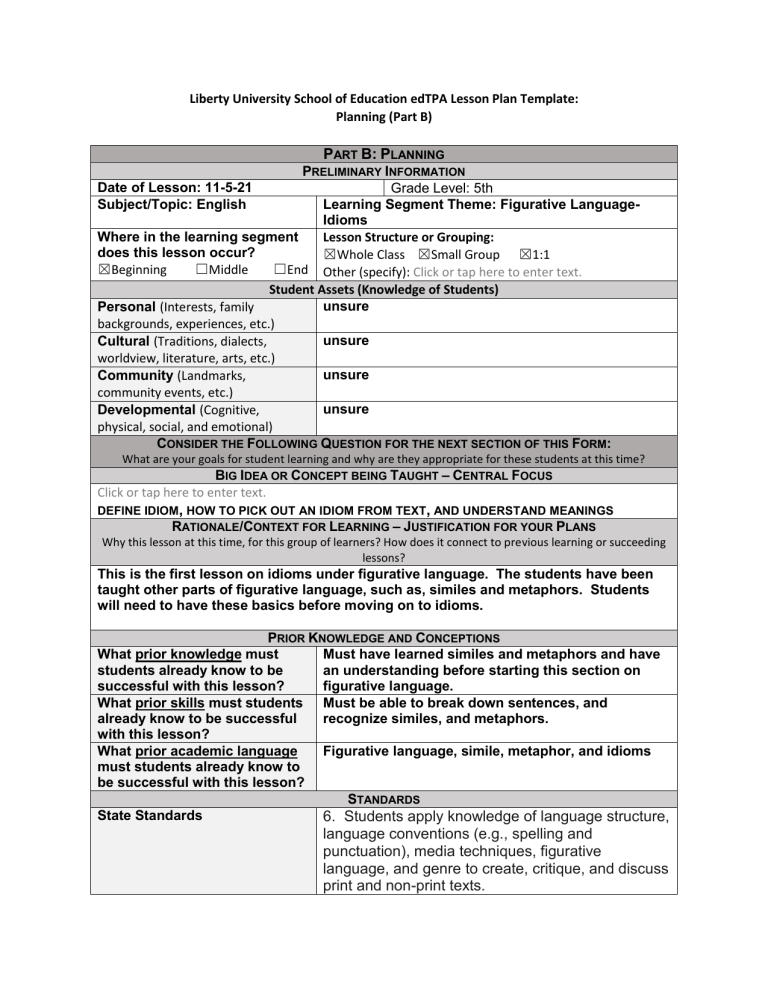
Liberty University School of Education edTPA Lesson Plan Template: Planning (Part B) PART B: PLANNING PRELIMINARY INFORMATION Grade Level: 5th Learning Segment Theme: Figurative LanguageIdioms Where in the learning segment Lesson Structure or Grouping: does this lesson occur? ☒Whole Class ☒Small Group ☒1:1 ☒Beginning ☐Middle ☐End Other (specify): Click or tap here to enter text. Student Assets (Knowledge of Students) unsure Personal (Interests, family backgrounds, experiences, etc.) unsure Cultural (Traditions, dialects, worldview, literature, arts, etc.) unsure Community (Landmarks, community events, etc.) unsure Developmental (Cognitive, physical, social, and emotional) CONSIDER THE FOLLOWING QUESTION FOR THE NEXT SECTION OF THIS FORM: Date of Lesson: 11-5-21 Subject/Topic: English What are your goals for student learning and why are they appropriate for these students at this time? BIG IDEA OR CONCEPT BEING TAUGHT – CENTRAL FOCUS Click or tap here to enter text. DEFINE IDIOM, HOW TO PICK OUT AN IDIOM FROM TEXT, AND UNDERSTAND MEANINGS RATIONALE/CONTEXT FOR LEARNING – JUSTIFICATION FOR YOUR PLANS Why this lesson at this time, for this group of learners? How does it connect to previous learning or succeeding lessons? This is the first lesson on idioms under figurative language. The students have been taught other parts of figurative language, such as, similes and metaphors. Students will need to have these basics before moving on to idioms. PRIOR KNOWLEDGE AND CONCEPTIONS What prior knowledge must Must have learned similes and metaphors and have students already know to be an understanding before starting this section on successful with this lesson? figurative language. What prior skills must students Must be able to break down sentences, and already know to be successful recognize similes, and metaphors. with this lesson? What prior academic language Figurative language, simile, metaphor, and idioms must students already know to be successful with this lesson? STANDARDS State Standards 6. Students apply knowledge of language structure, language conventions (e.g., spelling and punctuation), media techniques, figurative language, and genre to create, critique, and discuss print and non-print texts. National Standards Students apply knowledge of language structure, language conventions (e.g., spelling and punctuation), media techniques, figurative language, and genre to create, critique, and discuss print and non-print texts. InTASC Alignment Standard #4: Content Knowledge – The teacher understands the central concepts, tools of inquiry, and structures of the disciplines(s) he or she teaches and creates learning experiences that make the discipline accessible and meaningful for learners to assure mastery of the content. LEARNING OBJECTIVE(S) These must be behavioral and measurable. Statements of what students will know, understand, and be able to do at the end of the lesson (consider all three domains). Include condition, performance, and criterion. Condition: Teacher will provide definition of Idiom and offer examples. THE TEACHER WILL ALSO ENCOURAGE THE STUDENTS TO THINK OF IDIOMS ON THEIR OWN. PERFORMANCE: STUDENTS WILL BE ABLE TO RECOGNIZE AND APPLY KNOWLEDGE OF AN IDIOM AND KNOW WHAT IT IS. CRITERION: GIVEN DEFINITIONS AND EXAMPLES, THE STUDENT WILL BE ABLE TO HEAR AND SEE AN IDIOM WHEN PRESENTED TO THEM. THEY WILL BE ABLE TO HAVE SOME UNDERSTANDING ON TRUE MEANINGS OF THE IDIOM. Language Demand(s) ACADEMIC LANGUAGE DEMANDS Be able to have an understanding of the English language. Be able to read. Language Support(s) Students who will need help with this, will be able to get help in small groups, and teacher will help in extra support to students who need it. Essential Vocabulary Introduction to new vocabulary words- Humor, ideas, and genuine. CONSIDER THE FOLLOWING QUESTION FOR THE NEXT SECTION OF THIS FORM: How will you know and document students’ progress towards meeting your learning objective? EVIDENCE AND ASSESSMENT OF STUDENT LEARNING How will you know whether your students are meeting your learning objective? What tools will you use to measure their progress? How will you provide feedback to promote student learning? Diagnostic/Pre-assessment(s) Give students a worksheet on idioms, evaluate comprehension and knowledge, according to answers given. Formative Assessments/ Feedback to Learners Ask students to think of idioms they may be familiar with and voice examples. Summative Assessments Give worksheet on idioms back to students and then have them go over it, and work on what each idiom’s true meaning is. EXPECTATIONS FOR STUDENT LEARNING – STANDARDS AND CRITERIA Describe in detail the following levels of student performance and what student’s work will look like in each circumstance. How will you communicate your expectations to students? Provide any rubrics you will use. Exceeds Expectations Students will be able to hear and see idioms in different settings. Meets Expectations The student can recognize and pick out meaning Below Expectations The student is unable to comprehend the meaning. CONSIDER THE FOLLOWING QUESTION FOR THE NEXT SECTION OF THIS FORM: How will you support students to meet your goals? Describe EXPLICITLY what you will do! List planned supports (instructional strategies, learning tasks and materials, and other resources deliberately designed to facilitate student learning of the central focus). Character Education Wise Proverbs 1:5- A Wise man will hear, and will increase learning, and a man of understanding shall attain unto wise counsels. Planned Supports Students will be able work in small groups, will extra one on one teacher help Resources and Materials Idiom worksheet, paper, pencil, textbook, computer Technology Connection Watch a video of different music videos, that have idioms used in text, and have the children to write the idioms they hear down. BEGINNING: LAUNCH/HOOK/ANTICIPATORY SET How will you get the lesson started? What questions, texts, inquiry, modeling, and/or other techniques will you use to engage students? Well, I guess the Cats out of the bag on this one. Students today we are going to talk about idioms. Can anyone tell me what an idiom is? What does what I said at the beginning really mean? Did I really let a cat out of a bag? MIDDLE: INSTRUCTIONAL STRATEGIES TO FACILITATE STUDENT LEARNING For example: How will you engage students with ideas/texts to develop understanding? What questions will you ask? How will you promote question generation/discussion? What activities will you use to engage students in learning—for individuals, small groups, or the whole class? How will you incorporate technology? How will you address the academic language demands? Detail your plan. Note: For math lesson plans, please write or attach every task/problem students will solve during the lesson—with the correct answers. Instruction/Modeling -Introduce idioms -Discuss meaning -Get children involved by telling idioms they know -Work on an idiom worksheet -Watch a video with idioms, and have children to write down idioms they have heard. -Look back at the worksheet, and work on what the true meanings of the idioms are. Guided Practice Students will have the opportunity to participate in a classroom discussion on different idioms and there meanings. Teacher will write idioms on board. Independent Practice Have students to write down as many idioms they can think of. END: CLOSURE How will you end the lesson in a way that promotes student learning and retention? The students have knowledge of what an idiom is, and how to recognize them when they see and hear them. They can thing about true meanings of what is being said. The student will complete a review on idioms. SUPPORTS: DIFFERENTIATION/EXTENSION How will you provide successful access to the key concepts by all the students at their ability levels? Exceptionalities (special needs [IEPs/504 plans], gifted and talented, accommodations, etc.) ELL I would adjust my plans to give more one-on-one instruction. Learning Styles/Student Engagement Visual- write idioms on board, video on idioms Hearing- instruction, and video hands-on- create idioms by using objects in a bag. Have several fun worksheets on idioms, to further their knowledge on the subject. Extension Give background on where idioms started or come from. Give detailed explanation WHAT IFS Be proactive. Consider what might not go as planned with the lesson. What will you do about it? What if students... What if a student finish their work early? Give them extra idiom fun worksheet to complete. What if students cannot... What if students cannot understand figurative language on idioms? Give them a partner who has a good knowledge that can help, teacher will be available for individual instruction. REFERENCES: MATERIALS AND RESOURCES Cite all sources used in the development of the lesson materials and resources, including URLs or other references. Educator.brainpop.com/lesson-plan/36-4-idioms-lesson-plan/ REFERENCES: RESEARCH TO SUPPORT INSTRUCTIONAL DESIGN Cite all research used to support instructional design, including URLs or other references. www.fluentu.com Everything you’ve gotta know to teach English idioms.

